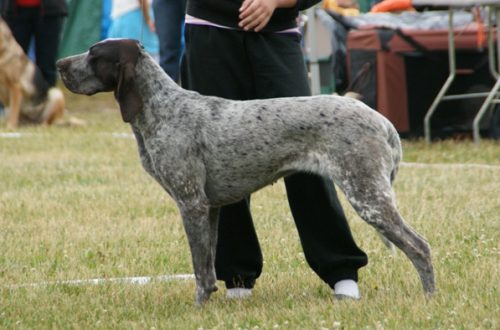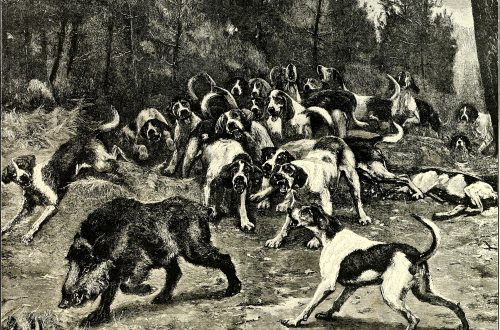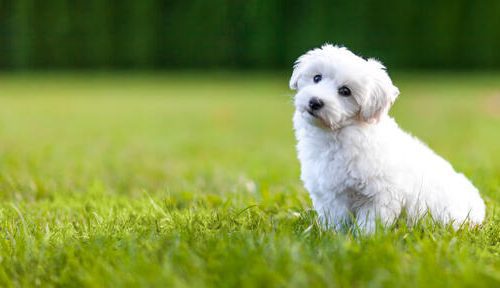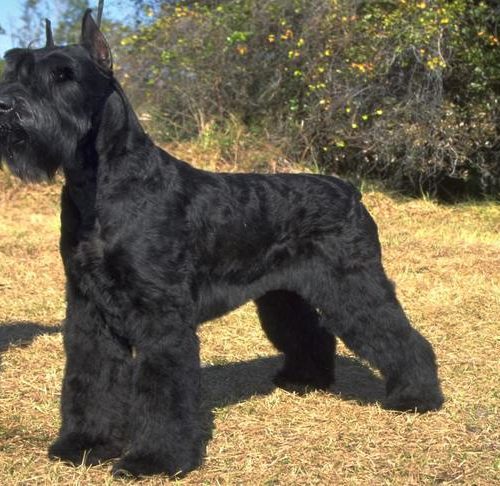
Giant Schnauzer
Other names: Riesenschnauzer
The Giant Schnauzer is a universal dog bred in the south of Germany for shepherd, security, and later detective activities. It has a textured appearance, thanks to the long adorning hair on the muzzle.
Contents
- Characteristics of Giant Schnauzer
- Basic moments
- History of the Giant Schnauzer breed
- Video: Giant Schnauzer
- Appearance of the Giant Schnauzer
- Photos giant schnauzer
- The nature of the Giant Schnauzer
- Education and training of Giant Schnauzer
- Maintenance and care
- Health and disease of Giant Schnauzers
- How to choose a puppy
- Photos of Giant Schnauzer puppies
- How much is a giant schnauzer
Characteristics of Giant Schnauzer
| Country of origin | Germany |
| The size | large |
| Growth | 59–70 cm |
| Weight | 32–35 kg |
| Age | 11–12 years old |
| FCI breed group | pinschers and schnauzers, molossians, mountain and swiss cattle dogs |
Basic moments
- The Giant Schnauzer is a powerful dog with a pronounced tendency to dominate. An experienced owner, or better, a professional trainer, should deal with her upbringing and training.
- The name of the breed literally translates as “giant muzzle” (from German Riese – giant, Schnauze – muzzle).
- The peak of the glory of the Giant Schnauzers in Russia fell on the 80-90s of the XX century. Today, representatives of this dog clan are not included in the list of the most popular pets, which did not in the least affect their athletic and working qualities.
- Adult animals do not need special complex care (the exception is dog hair), but they require regular training and long walking. In this regard, for the elderly and inactive people, such a pet will become more of a burden than a friend.
- In every stranger, the Giant Schnauzers see, if not an enemy, then a very suspicious person. At the same time, they have an amazing memory for faces, thanks to which animals are able to recognize people they have encountered only once.
- Too much free time for dogs is the worst of evils. The nature of Giant Schnauzers idle for days is changing rapidly, and not for the better. Animals begin to withdraw into themselves, cunning and cease to obey the owner.
- This breed is very fond of rescuers and representatives of law enforcement agencies, since it is from its representatives that the best search engines and hunters for offenders are obtained.

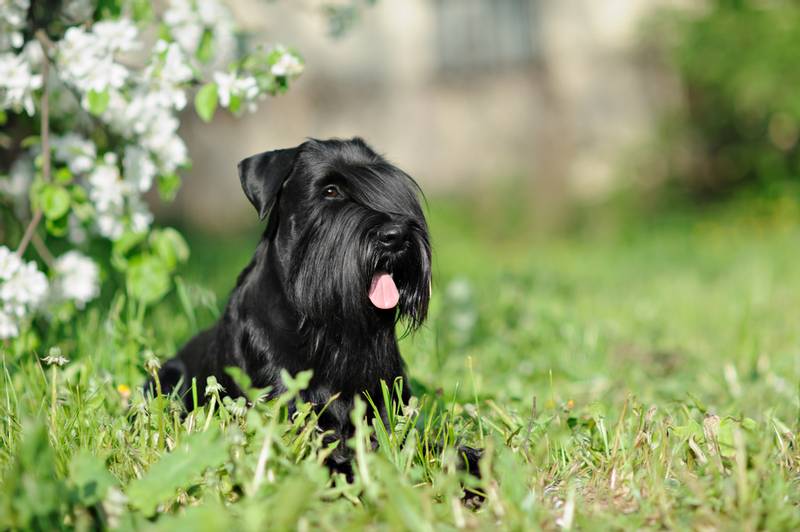
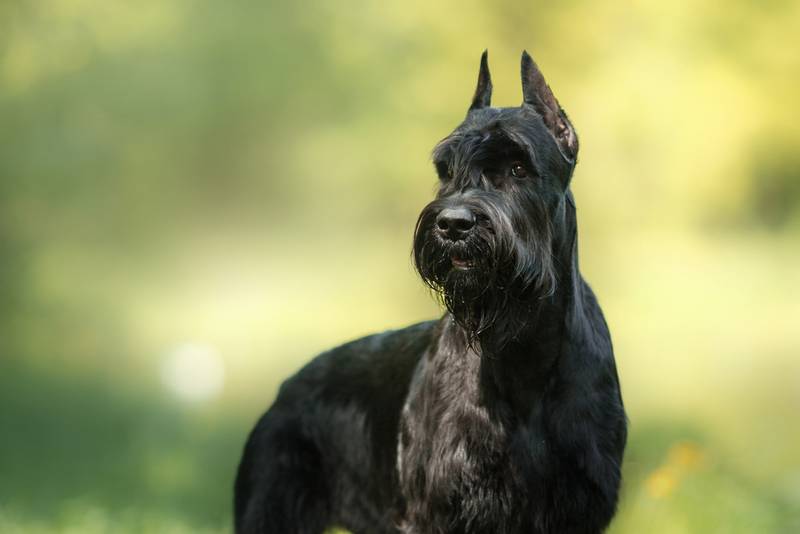
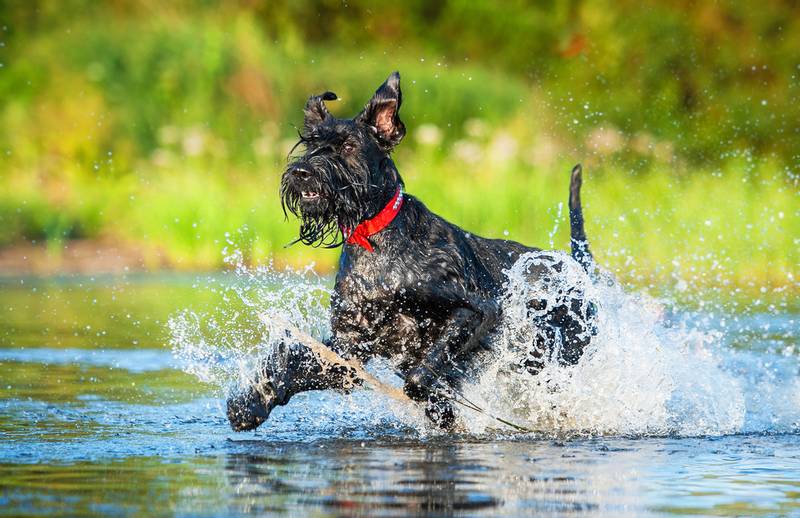
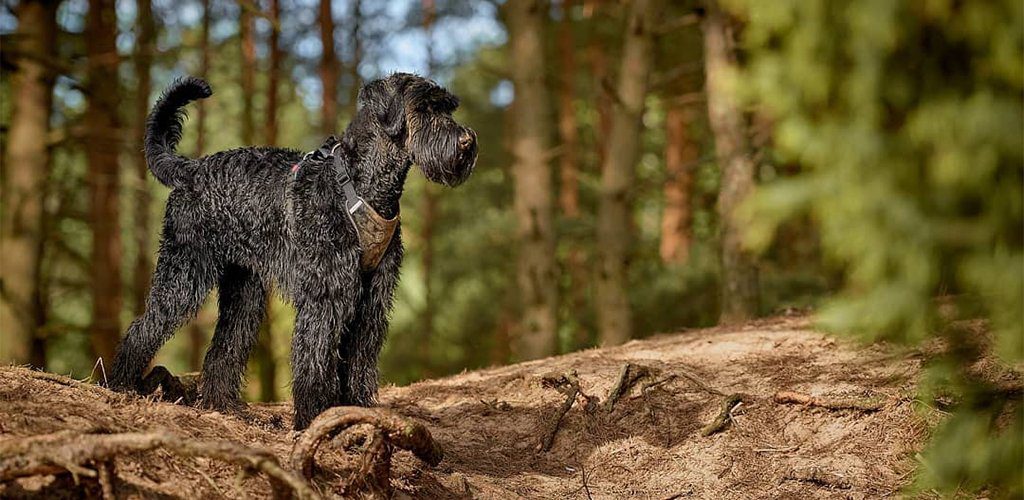
Giant Schnauzers are intellectuals and workaholics who have mastered about a dozen canine professions and secured their place under the sun due to outstanding working qualities, sharpness of mind and almost human ingenuity. However, like any service breed, these mustachioed sly ones will require a special approach. Serious and proud, they will not run, wagging their tail, at the first call and will definitely try to impose their rules of the game on anyone who allows it. So if you are tired of serving dogs dissolving in their own owner and are in search of a serious friend with a strong, independent character, you are exactly on the way with a Giant Schnauzer.
History of the Giant Schnauzer breed
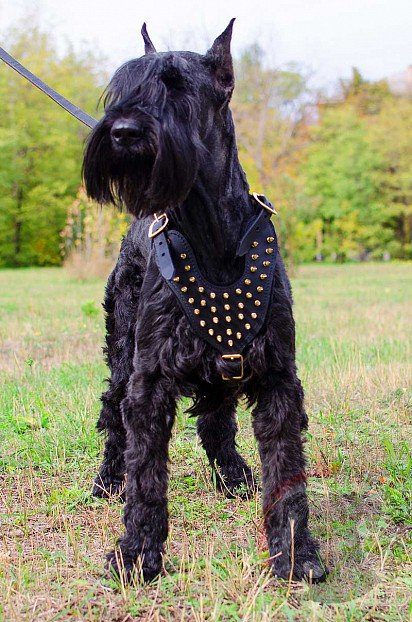
The ancestors of the Giant Schnauzers were typical villagers who did not have a narrow service specialization, and therefore they were used for a long time as dogs “for everything”. Herd of sheep flocks, protection of farm estates, protection of the owner and his property – the Giant Schnauzers coped well with all these activities, which earned the respect of the German peasantry. The breed is especially widespread in the south of Germany, as well as in the border regions of Austria and Switzerland. The stingy Bavarian farmers quickly realized that such universal pets could be charged with any dog work and rushed to multiply their numbers.
As for the true origin of the “giant muzzles”, everything here is very, very vague. Moreover, the degree of kinship between the Giant Schnauzers and the Standard Schnauzers has not been fully clarified. It is only known for sure that at some point the Pinscher genes were merged into both breeds. But when exactly this happened and with whose help it is almost impossible to establish today.
By the middle of the 19th century, large-faced dogs began to gradually go out into the world. In particular, the first purebred Giant Schnauzers can be seen in the portraits of the Bavarian Princess Elisabeth, as well as in the images of other important people of that time. Animals began to appear at cynological events since 1902, but the real interest in the breed among breeders woke up only in 1909, after 29 Giant Schnauzers were presented to guests at the Munich exhibition.
At first, the dogs were dubbed the Munich Schnauzers, but several alternative nicknames were assigned to them among the people. So, for example, German burghers preferred to call animals beer schnauzers, as the owners of Bavarian eateries often delivered their foam products to them. The breed received its modern name only in 1923, along with the official appearance standard.
In the USSR, they learned about the existence of Giant Schnauzers in the 20s of the XX century, but no one dared to seriously engage in their breeding. The specialists of the Krasnaya Zvezda nursery were able to correct the situation. In the early 1970s, two purebred littermate puppies, Akbar f. Raaksee and Annie f. Raaksee, who later became the great-grandmother and great-grandfather of all Russian Giant Schnauzers.
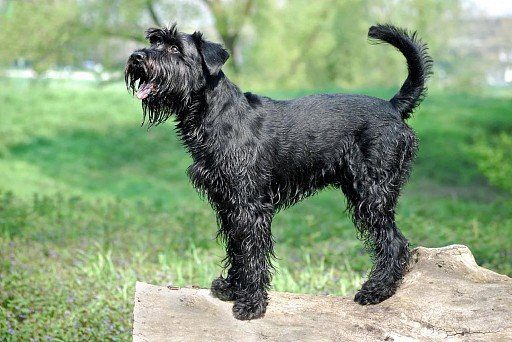
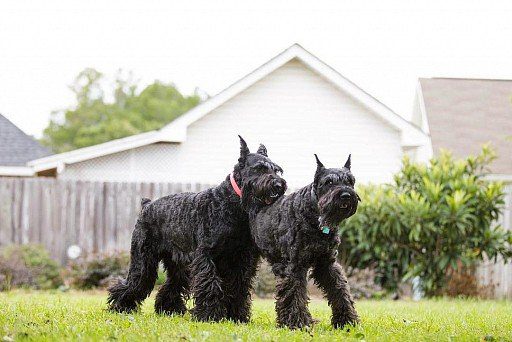
Video: Giant Schnauzer
Appearance of the Giant Schnauzer
The Giant Schnauzer is a mustachioed-bearded strong man with excellently developed muscles. To date, this is the largest variety of schnauzer of all existing (mittel- and miniature schnauzers are more modest in size). The growth of the average Rizen male fluctuates between 60-70 cm, and its weight should not exceed 47 kg.
Head
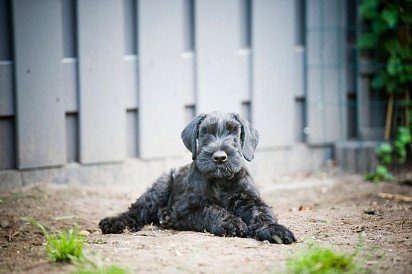
The Giant Schnauzer has an oblong skull with a flat forehead and no pronounced occiput. The muzzle is wedge-shaped, not pointed. Relief stop.
Jaws and teeth
All representatives of the breed have strong, strong jaws with a full dentition (42 teeth) and a scissor bite.
Nose
The bridge of the nose is straight, without dips. The lobe is black, large, with large nostrils.
Eyes
The eyes of the Giant Schnauzer are small, dark, set straight. The eyelids are close to the eyeball.
Ears
The high-set, moderately hanging ears of Giant Schnauzers have a classic triangular shape. The front edge of the ear should touch the dog’s cheekbones, the optimal height of the fold of the ear cloth is at the level of the skull. Previously, for aesthetic purposes, the ears were cropped. Today, the procedure is banned in most European countries, although most domestic breeders continue to practice it.
Neck
The Giant Schnauzer has a slender, graceful, but at the same time very muscular neck without skin folds. In the region of the neck, the cervical vertebrae form a slight bend.
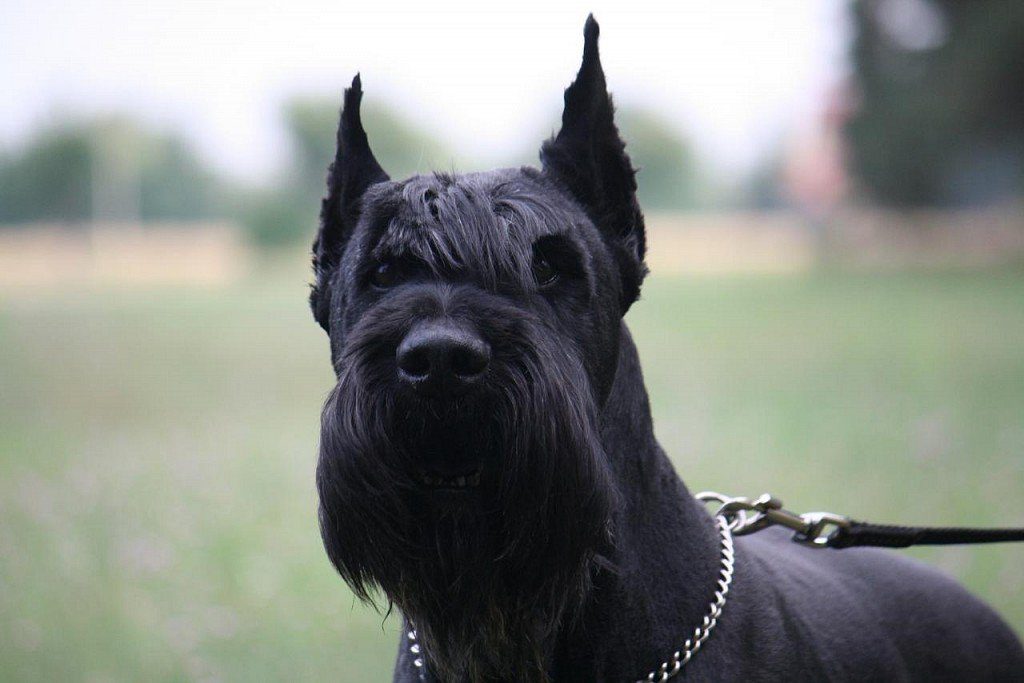
Frame
The body of the Giant Schnauzer is quite compact with a short, strong back and a convex-deep lumbar region. The sides and belly are shaped, which gives the silhouette of the dog additional harmony. The croup in purebreds should be slightly sloping, and the chest not too broad and slightly protruding forward beyond the shoulder joints.
Giant Schnauzer limbs
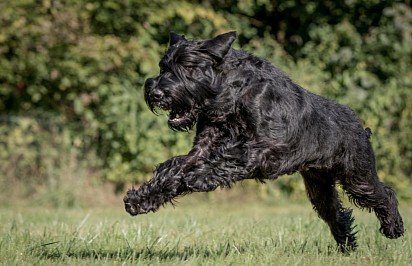
The Giant Schnauzer has straight, moderately wide set legs. The shoulder blades are of an oblique type with good musculature, the elbows are pressed to the body. Hind limbs in purebred individuals should be pulled back. Preferred: Wide, well-lengthened thighs, normal knees without obvious inward or outward turning, and cat-like (arched) feet.
Tail
Saber-shaped, normal length. Like the ears, the tail of Russian Giant Schnauzers is often docked.
Wool
The coat of the Giant Schnauzer is hard, resembling a wire to the touch. The coat is of a double type, consisting of an abundant undercoat and a coarse, not very long awn. The coarsest and longest hair grows on the muzzle of the dog, forming expressive “mustache” and “eyebrows”.
Color
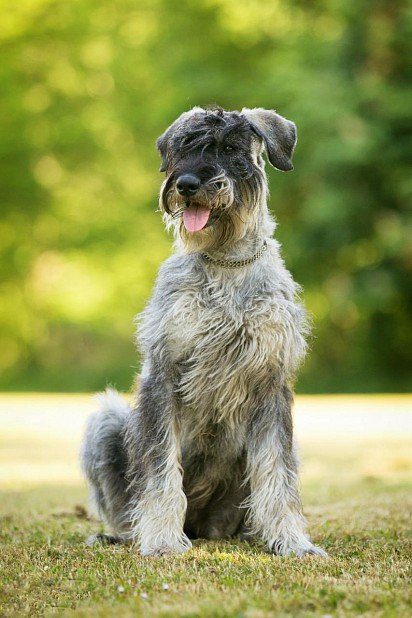
The officially recognized types of colors are black and the so-called “pepper and salt”.
Defects and disqualifying vices
Any deviation from the breed standard is already a defect, but if the defect is not very pronounced, the exhibition commission may turn a blind eye to it. But owners of animals with inverted elbows, a lightweight body type and straightened hocks should not count on such concessions.
Disqualifying vices of Giant Schnauzers:
- deviations from scissor bite (overshot, undershot, jaw misalignment);
- insufficient / excessive growth (with a deviation of 4 cm or more in any direction);
- congenital deformities and pathologies;
- inadequate behavior (unreasonable cowardice, aggression, suspicion);
- inconsistency with the breed type;
- body defects, color and coat.
Photos giant schnauzer
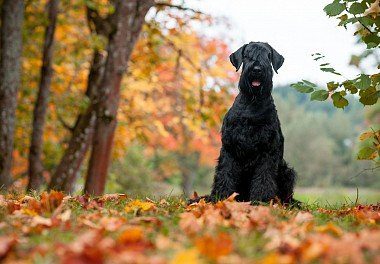
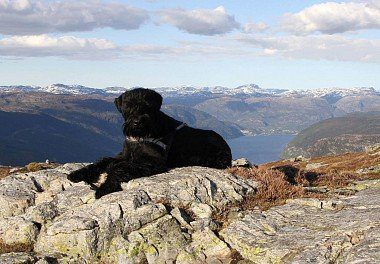
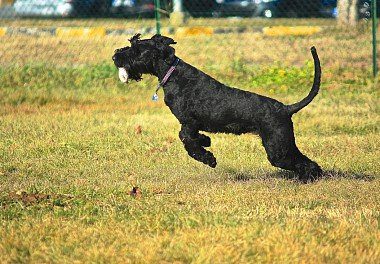
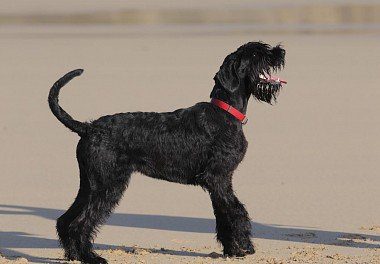
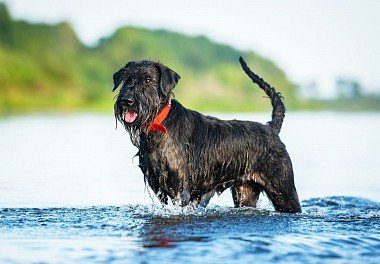
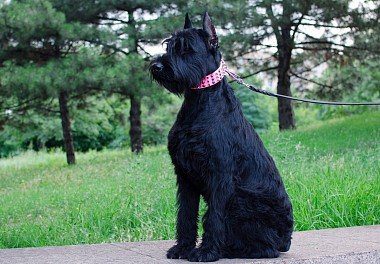
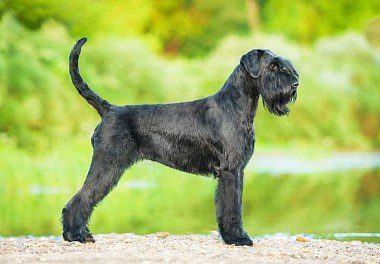
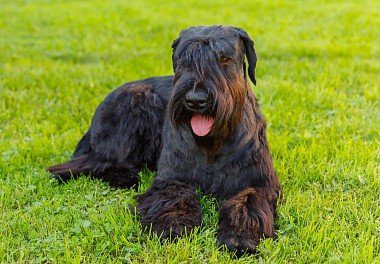
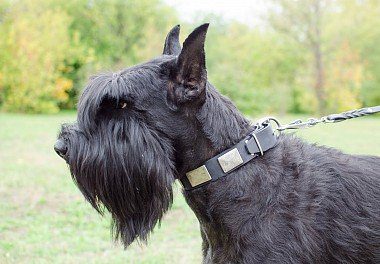
The nature of the Giant Schnauzer
Giant Schnauzers are hard workers, what to look for. True, it is worth making a reservation here: the rizens will work only for the benefit of the owner who managed to prove his own viability to them. In general, leadership in the breed is in the blood, thanks to which the representatives of this canine clan enjoy a reputation as difficult-to-educate creatures. Starting from the first days of life, the Giant Schnauzer respects only himself and the one who is stronger and more cunning, therefore, when acquiring a home “Bavarian”, consider whether you can maintain your own authority in the eyes of your pet 24 hours a day throughout his life. Dogs have a very warm relationship with children. Most Giant Schnauzers are not averse to running after a restless baby and participating in harmless pranks. There are also enough exceptions to the general rule, but in general, animals are not inclined to show aggression towards those
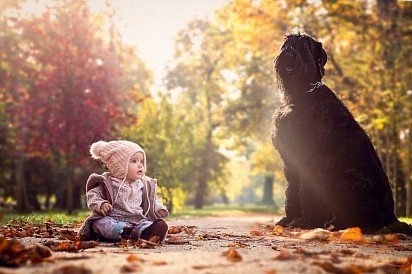
You can write endlessly about the energy of the breed. Giant schnauzers are fast, tireless and able to switch from a sleeping state to full combat readiness with lightning speed. It’s not that hard to piss off a dog if you’re a stranger. One has only to slightly raise his voice to her master or touch him not very friendly. All! Get ready to fight off the attack of a furious four-legged guard who saw you as the main criminal of all times and peoples. And yet the passion for the performance of official duties does not turn the Bavarians into boring, ferocious crackers. Quite the contrary, at home, Giant Schnauzers are quite sweet and good-natured. Moreover, with the right training methodology, they easily curb their own impulsiveness and excitement.
By nature, Giant Schnauzers are very inventive and cunning and enjoy using these qualities in everyday life. They will gladly fool their own owner if he allows, so you will have to keep your finger on the pulse with this breed all the time. Do not discount the curiosity and sociability of the Giant Schnauzers. For normal development, the mustachioed “Bavarians” simply need to contact the owner to the maximum, comprehending the science of conducting an adequate dialogue. If you get a Giant Schnauzer in the hope that he will just sit in the corner, guarding your wealth, you have chosen the wrong breed.
Education and training of Giant Schnauzer
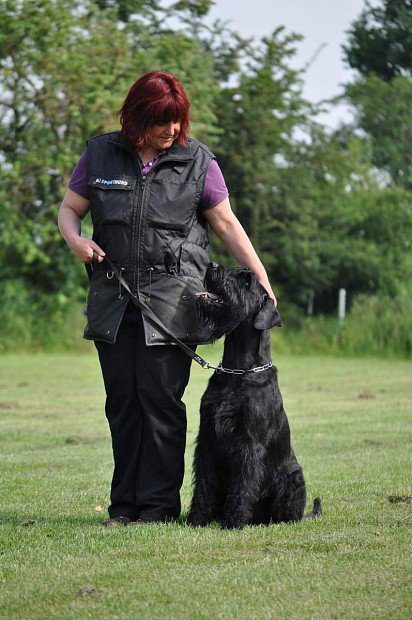
Whatever activity you involve Giant Schnauzers in, they will always demonstrate excellent results. Ride a baby on a sled, threaten a thief encroaching on the owner’s good, or save a drowning man – properly trained rizens can do everything and a little more than that. However, almost all representatives of this glorious family can boast not only a high level of intelligence, but also an outstanding degree of stubbornness, so experts classify the Giant Schnauzer as a breed that needs early training. Moreover, according to an experienced trainer and author of the book “Giant Schnauzer”, Rüdiger Blüdau, “giant muzzles” will have to be trained throughout their life, because they are thinking and erudite animals, from which it is impossible to educate blind executors of the master’s will.
The qualities that each owner must strive to develop in his Giant Schnauzer are restraint and obedience. Never reward a puppy barking at strangers. The nature of the breed is already quick-tempered, so it is better to extinguish sudden outbursts of aggression at a young age. Studying for Giant Schnauzers is easy, but animals will still try to play the leader, so keep yourself serious during classes. Lessons are best done in a playful way with obligatory encouragement at the end. But first, take your pet for a walk so that he throws out energy and becomes more focused. Giant Schnauzers don’t like to work on a full stomach either, so don’t feed your puppy before training. If during the lessons the dog shows cunning, do not rush to scold her, on the contrary, try to quietly bypass the traps set by her. But if your ward stubbornly ignores commands, you should think about it. Most likely, the Giant Schnauzer is testing your authority for strength. Pull such a trick once or twice – and you can forever forget about the hope of raising a well-mannered dog.
Owners of show-class animals will have to pay increased attention to their socialization. Exhibition individuals should calmly endure the touch of other people’s hands and not growl at the approaching groomer. You can fight the breed’s caution by walking your pet in crowded places and near busy highways, as well as traveling with him on public transport. In advance, introduce the Giant Schnauzer to the ring. This type of leash is not the most comfortable design for dogs, so if you put it on the animal too late, you can cause him to panic and have a lifelong disgust for such gizmos. Walking the Giant Schnauzer in the ring should be done carefully, making sure that he does not tighten the loop around his neck. When it comes to practicing the show stance, the handler can’t do without reward treats to help keep the dog in the right position.
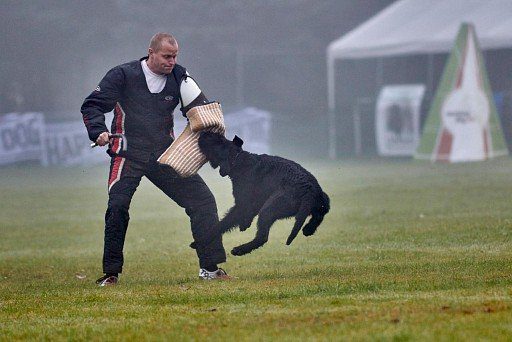
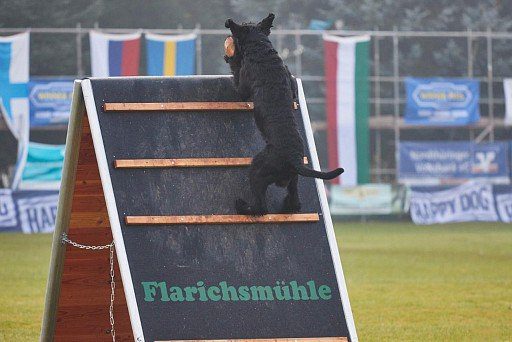
Maintenance and care
Despite not the smallest dimensions, the “Bavarians” do not take up much space in the house and do not turn it upside down. It is quite possible to grow a well-mannered apartment dweller from a giant schnauzer, provided that you do not refuse the animal in long walks and active games in the fresh air. And yet, a more acceptable housing option for dogs of working breeds remains the yard of a private house, where the animal can move freely and contact people.
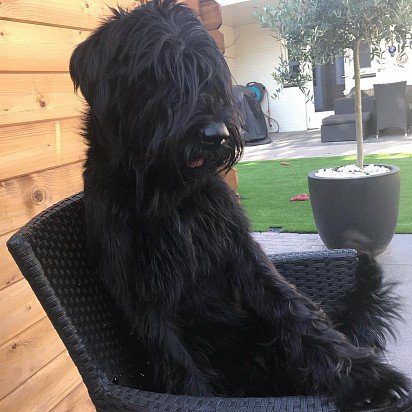
Be sure to consider the option of shelter from the weather for a yard pet. For example, an outdoor enclosure for a Giant Schnauzer should have a canopy and a plank floor, on which an insulated booth with a removable roof and a snow damper is installed. If the winters in your area are harsh, you can install electric heating in your pet’s home, but for a period of severe frosts, it’s better to take the dog into the house. The same rule applies to older animals. Giant Schnauzer, who celebrated his 8th birthday, on damp, cool nights, it is better to start spending the night in housing. Otherwise, get ready for cold kidneys, aching joints and other consequences of hypothermia.
Putting a Giant Schnauzer on a chain is a real mockery of his pride and temperament. If there is an urgent need to temporarily limit the dog’s habitat (for example, during the arrival of a large number of guests), close it for several hours in an aviary or house.
Giant Schnauzer Hygiene
The Giant Schnauzer has an amazing coat: thick, dense, repels water and pollution and perfectly protects the dog from minor injuries. Moreover, the well-groomed and clean coat of the “Bavarians” does not smell like a dog. There is an opinion that Giant Schnauzers shed differently than most other breeds, and that their coat does not shed. In fact, if the pet is not deliberately cared for, then it will lose dead hair with the same intensity as mongrel dogs, so the only way to avoid woolen tufts flying around the apartment is systematic trimming (pinch). You can carry out the procedure manually, grabbing and pulling out tufts of dead hair with your fingers, or using a trimming knife. After shedding hair is removed, it is necessary to carefully examine the dog’s skin and treat the injured areas with chlorhexidine.
Important: the first pinch for Giant Schnauzer puppies is carried out at 6 months of age.
An alternative to trimming can be the use of a roller or furminator to help remove excess undercoat and dead outer hair (for non-show dogs). Giant schnauzers are trimmed mainly to improve the exterior. A typical haircut scheme: the maximum shortening of the hair on the ears, throat, back of the thighs and in the crotch. In other parts of the body, the hair is only slightly worked out with thinning scissors. They wash dogs as needed with sulfuric or tar shampoos (tar soap will do). But it is better to comb the “Bavarians” more often, first with a rare comb that breaks the resulting tangles, and then with a comb with frequent teeth.
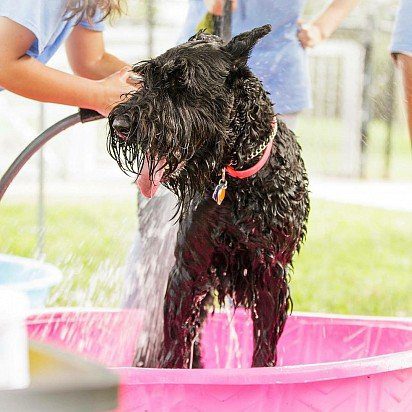
To improve the structure of the coat of the Giant Schnauzer, burdock oil is suitable, which is rubbed into pre-washed and dried dog hair (not earlier than a week after trimming). The same effect is given by dietary supplements based on chitin and salmon oil. Be sure to dry the hair on your pet’s face after he has eaten to prevent fungal growth. If the Giant Schnauzer managed to hang fat on his “mustache”, wash them with soap and then dry with a towel.
Owners of pepper-colored show individuals will have a little more difficulty, since the “beards” of such animals turn yellow upon contact with food. You will have to remove the unwanted fawn tone with special whitening cosmetics sold in veterinary pharmacies and grooming salons. The same problem can occur in black Giant Schnauzers, which often burn out in the sun. It is best to neutralize the resulting redness on the “fur coat” of the dog with a tinted shampoo.
With the beginning of the swimming season, the hair of Giant Schnauzers will have to be monitored more carefully, so if your pet is accustomed to swim in a river or pond, then firstly, give him an antifungal vaccination, and secondly, buy him an anti-dandruff shampoo with an antifungal effect. Dog eye and ear care is standard. Keep them clean by removing accumulated dirt with clean wipes. Additionally, you can pluck the hair inside the animal’s ear funnel. So it will be better for air to circulate in it, and sulfur secretions will cling to the hairs less.
Paddock
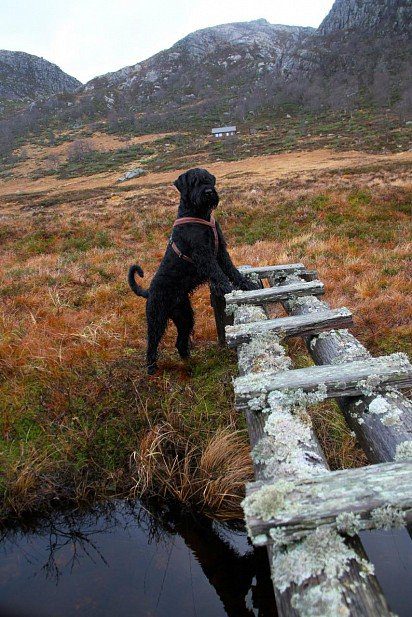
Twice a day the Giant Schnauzer is taken out for a walk. The minimum duration of such exits for a puppy is 30 minutes, for adult dogs – 1 hour. They walk the kids on a leash, but in calm, safe places they lower it off so that the animal can go about its business and relax. If the pet is overly carried away by digging holes or chasing a stray cat, which Giant Schnauzers simply adore, he should be called to him, offering a game or a treat. In cases where the reaction to the command is zero, it is better to simply approach the puppy and fasten the leash to him.
For your information: adult dogs living in an apartment will not be satisfied with walks at a sluggishly relaxed pace. The best option is to combine your own sports training with walking your pet. The Giant Schnauzer will gladly run after your bike or scooter and with no less pleasure will accompany you on a morning run. Owners of dogs living in household plots and fenced areas are a little easier in this regard. Their wards are not as limited in activity as apartment rizens.
Not taking your puppy outdoors until he is 4 months old is a big mistake, although some experts recommend doing so. Animals that were kept cooped up to adolescence are poorly socialized, afraid of people and have problems with the toilet. By the way, about the toilet: young Giant Schnauzers categorically do not want to go to a diaper or a newspaper, so the sooner you teach the dog to relieve himself on the street, the easier it is for you.
Giant Schnauzer Feeding
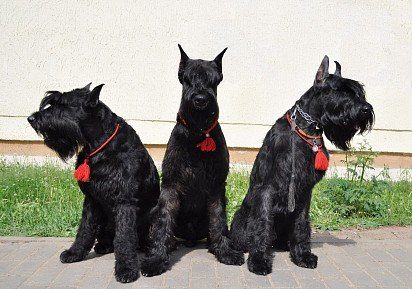
The daily menu of the Giant Schnauzer is not much different from the diet of other large breed dogs. Low-fat raw meat (except chicken and lamb), offal, sour milk are supplemented with vegetables, sea fish and cereals. Young dogs that do not have problems with teeth and digestion will benefit from chewing on the bones of the brain, which serve as a source of calcium.
Natural vitamin supplements should not be abandoned either. In particular, it is useful for Giant Schnauzers to mix seasonal greens, vegetable oil (sunflower, linseed), sea kale into food. It’s great if you managed to accustom your pet to fruit salads, as well as dried apples, pears, but don’t overdo it. About ¼ of an adult dog’s diet should be meat, not fiber.
As for junk food, for the Giant Schnauzer breed, this is, first of all, food from the master’s table. Once and for all, refuse your ward in spicy, salty, fatty foods, as well as sweets and pastries. River fish, tubular bones and cereal crops complete the top of non-usefulness.
What not to do:
- feed the Giant Schnauzer with protein food, that is, combine meat and fish or offal and eggs in one feeding;
- cook meat and bones. Raw food is much healthier for Giant Schnauzers;
- grind food, especially meat, to the state of minced meat;
- save on vitamin and mineral supplements. Even if the menu of your Giant Schnauzer is very diverse, this will not insure him against beriberi;
- treat the dog with unfrozen meat, which can be infected with toxoplasma.

Health and disease of Giant Schnauzers
Properly eating and receiving qualified veterinary assistance, the Giant Schnauzer is able to live up to 10-12 years. At the same time, no animal is immune from hereditary predisposition to certain types of diseases.
Typical ailments of the breed:
- hypothyroidism;
- diabetes;
- pancreatitis;
- volvulus;
- lipoma:
- melanoma;
- hip dysplasia;
- cataract.
The urinary system of representatives of this breed is also not the healthiest, therefore, in the cold season, Giant Schnauzers easily catch kidney infections.
How to choose a puppy
Gather as much information as possible about the parents of the puppies: do they have show diplomas, have they been tested for working qualities. Be sure to specify how many siblings your potential pet had. Giant Schnauzer females can produce up to 14 puppies, but such extremes are best avoided. The optimal number of babies in a litter is 6-8. Only in this case, you can be sure that the tiny Giant Schnauzers had enough mother’s milk and they will not have problems with immunity.
The optimal age for the little Bavarian to move to a new home is 1.5 months. By this time, all the incisors appear in the baby, which makes it possible to determine the correctness of his bite. External data is an equally important selection criterion. A Giant Schnauzer puppy should be moderately well-fed, but not fed to the state of a clumsy square, its coat should be clean and shiny, and its head should be large. It is better to take babies with a rich black color of the lips and eye rims: in 99 cases out of 100 such animals will have a reference black coat. If you take a puppy from a breeder whose wards live in the yard, be prepared for a small amount of fleas on the baby’s “fur coat”. This phenomenon is common for yard dogs and does not affect the working qualities in any way, so it’s definitely not worth blaming the seller. Another thing is if small Giant Schnauzers are kept in cramped conditions,
The most promising are active, cheerful puppies that manage to take the most advantageous place at the food bowl. But too cowardly, as well as showing the initial signs of aggression, the Giant Schnauzers are an unsuccessful option for a pet. By the way, if you are not adept at training dogs of large breeds, but continue to dream of a Giant Schnauzer, opt for kennels specializing in show class animals. Leave the breeders who exclusively breed working animals to the pros. It is unlikely that you will cope with the rizen, in which the blood of several generations of aggressive service dogs flows.
Photos of Giant Schnauzer puppies

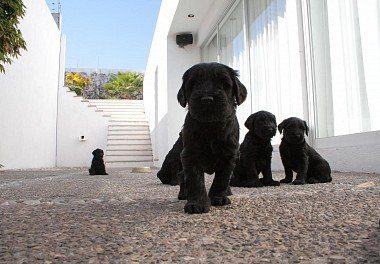
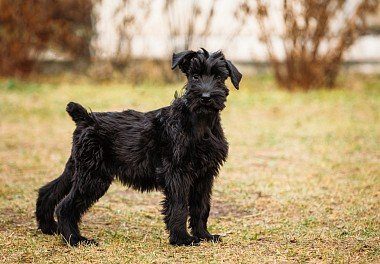
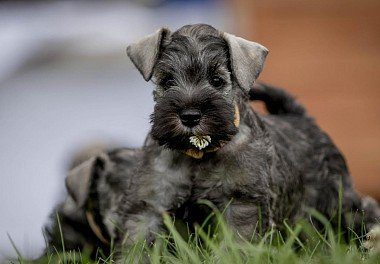
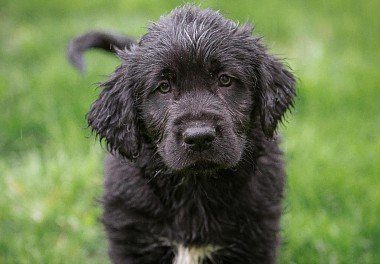
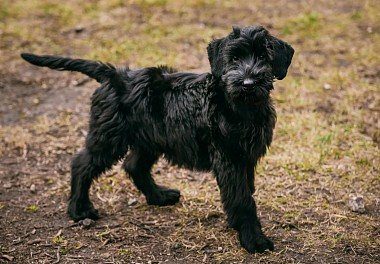
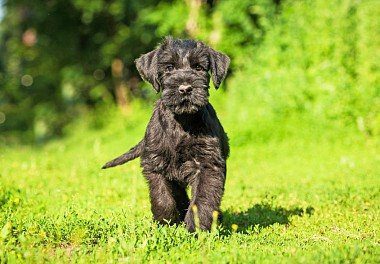
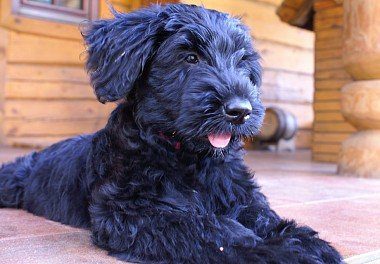
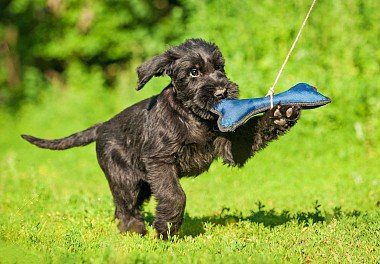
How much is a giant schnauzer
For a promising Giant Schnauzer puppy born from two champions, you will have to pay from 600 to 750$. Babies from a female and a male who have working certificates of OKS and ZKS will cost significantly less – an average of 300 – 400$. Offspring from unregistered matings are sold at a reduced cost – 60-120$.



